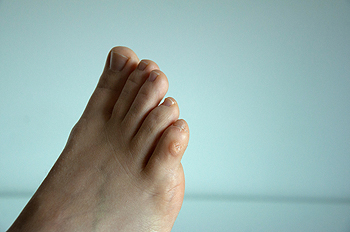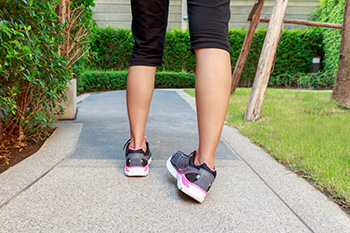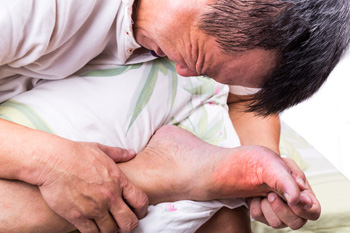

Corns are a condition of the feet that is primarily defined by hard layers of skin that develop in response to friction. Corns, importantly, are distinct from calluses. Many patients and novices to the field of podiatry often wonder where, exactly, corns can develop on the feet. The answer is slightly complicated. Corns are most commonly located on the soles, or bottoms, of the feet. However, they can also be found elsewhere on the feet. For example, corns can also be found on bony parts of the foot. This is to say that corns can be located on the toes, especially around the joints. You might also be most susceptible to developing corns wherever the skin is particularly thin. If you are someone that is concerned about developing corns on your feet, it is suggested that you contact a podiatrist today for more information. Schedule an appointment today.
If you have any concerns regarding your feet and ankles, contact the podiatrists of The Foot & Ankle Center of New Jersey. Our doctors will treat your foot and ankle needs.
Corns: What Are They? and How Do You Get Rid of Them?
Corns can be described as areas of the skin that have thickened to the point of becoming painful or irritating. They are often layers and layers of the skin that have become dry and rough, and are normally smaller than calluses.
Ways to Prevent Corns
There are many ways to get rid of painful corns such as wearing:
Treating Corns
Treatment of corns involves removing the dead skin that has built up in the specific area of the foot. Consult with Our doctors to determine the best treatment option for your case of corns.
If you have any questions please feel free to contact our office located in Paramus, NJ . We offer the newest diagnostic and treatment technologies for all your foot and ankle needs.

Athlete’s foot is a skin infection that is caused by a fungus that lives in moist environments such as locker rooms and shower room floors. The symptoms patients often experience can consist of itching, burning, and cracked skin between the toes, and the bottom of the feet may itch too. Athlete’s foot is contagious, and it is advised to wear water shoes or flip-flops to help prevent the fungus from spreading when visiting the public places mentioned. It can help to keep the toenails short and properly trimmed. Additionally, it is suggested to refrain from sharing shoes, socks, and towels. Washing and drying the feet daily may help to control the symptoms of athlete's foot followed by applying foot powder inside of the shoes. If you have developed this condition, please consult with a podiatrist who can offer you additional preventive methods to avoid getting athlete’s foot.
Athlete’s foot is an inconvenient condition that can be easily reduced with the proper treatment. If you have any concerns about your feet and ankles, contact the podiatrists from The Foot & Ankle Center of New Jersey. Our doctors will treat your foot and ankle needs.
Athlete’s Foot: The Sole Story
Athlete's foot, also known as tinea pedis, can be an extremely contagious foot infection. It is commonly contracted in public changing areas and bathrooms, dormitory style living quarters, around locker rooms and public swimming pools, or anywhere your feet often come into contact with other people.
Solutions to Combat Athlete’s Foot
Athlete’s foot can cause many irritating symptoms such as dry and flaking skin, itching, and redness. Some more severe symptoms can include bleeding and cracked skin, intense itching and burning, and even pain when walking. In the worst cases, Athlete’s foot can cause blistering as well. Speak to your podiatrist for a better understanding of the different causes of Athlete’s foot, as well as help in determining which treatment options are best for you.
If you have any questions please feel free to contact our office located in Paramus, NJ . We offer the newest diagnostic and treatment technologies for all your foot and ankle needs.

A twisted ankle is the most common cause of torn ligaments, also called ankle sprains. The foot rolls under and over-stretches the ligament that helps to stabilize the ankle joint. This can occur while stepping off a curb, landing on the foot wrong while walking or running, or playing sports where a lot of running and jumping are involved. Symptoms of an ankle sprain include pain, bruising, a loose feeling in the joint, and difficulty bearing weight. The incident may have generated a popping sound, and the ankle may begin to swell. The first way to deal with a sprained ankle is to cease the activity. Depending on the severity of the sprain, you may wish to see a medical professional, such as a podiatrist, as soon as possible. In the meantime wrapping the ankle to keep down the swelling, keeping it elevated, and applying ice is a good stopgap measure. It is exceedingly important to allow an ankle sprain to heal completely. If this is ignored, the chances are that the ankle will be re-injured, and sprains may become a chronic condition. For more information about an ankle sprain, please consult a podiatrist for an exam and long term treatment plan.
Ankle sprains are common but need immediate attention. If you need your feet checked, contact the podiatrists from The Foot & Ankle Center of New Jersey. Our doctors can provide the care you need to keep you pain-free and on your feet.
How Does an Ankle Sprain Occur?
Ankle sprains take place when the ligaments in your ankle are torn or stretched beyond their limits. There are multiple ways that the ankle can become injured, including twisting or rolling over onto your ankle, putting undue stress on it, or causing trauma to the ankle itself.
What Are the Symptoms?
Preventing a Sprain
Treatment of a Sprain
Treatment of a sprain depends on the severity. Many times, people are told to rest and remain off their feet completely, while others are given an air cast. If the sprain is very severe, surgery may be required.
If you have suffered an ankle sprain previously, you may want to consider additional support such as a brace and regular exercises to strengthen the ankle.
If you have any questions please feel free to contact our office located in Paramus, NJ . We offer the newest diagnostic and treatment technologies for all your foot and ankle needs.

If your big toe is red, swollen, and radiating extreme pain, you may have developed a case of gout, which is a form of arthritis. Gout occurs when the body contains too much uric acid. This acid forms crystals that collect in the joints, commonly the first metatarsophalangeal (MTP) joint of the big toe. This results in inflammation that swells and reddens the skin around the joint. The pain usually starts in the morning and increases throughout the day. It can come on suddenly, and it can be quite severe. Gout also can cause stiffness in the MTP joint, which may make it difficult to walk. If gout is not treated immediately, it can become chronic and spread to other joints, such as the ankles, knees, fingers, and wrists. A podiatrist can prescribe medications and suggest lifestyle changes that can help to reduce the flare ups of gout. If you have been experiencing the symptoms of gout on a regular basis, it is wise to seek the help of a podiatrist immediately.
Gout is a foot condition that requires certain treatment and care. If you are seeking treatment, contact the podiatrists from The Foot & Ankle Center of New Jersey. Our doctors will treat your foot and ankle needs.
What Is Gout?
Gout is a type of arthritis caused by a buildup of uric acid in the bloodstream. It often develops in the foot, especially the big toe area, although it can manifest in other parts of the body as well. Gout can make walking and standing very painful and is especially common in diabetics and the obese.
People typically get gout because of a poor diet. Genetic predisposition is also a factor. The children of parents who have had gout frequently have a chance of developing it themselves.
Gout can easily be identified by redness and inflammation of the big toe and the surrounding areas of the foot. Other symptoms include extreme fatigue, joint pain, and running high fevers. Sometimes corticosteroid drugs can be prescribed to treat gout, but the best way to combat this disease is to get more exercise and eat a better diet.
If you have any questions please feel free to contact our office located in Paramus, NJ . We offer the newest diagnostic and treatment technologies for all your foot and ankle needs.